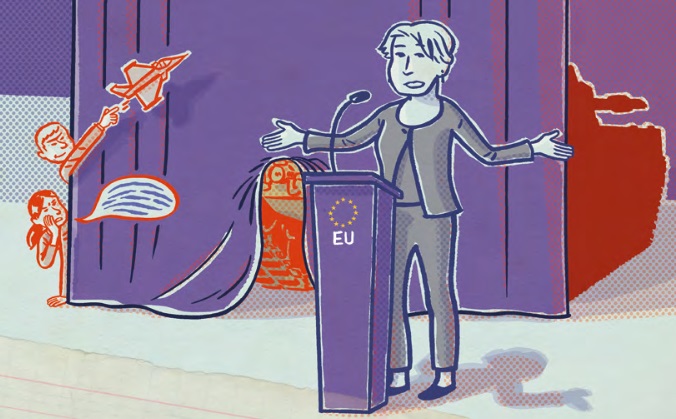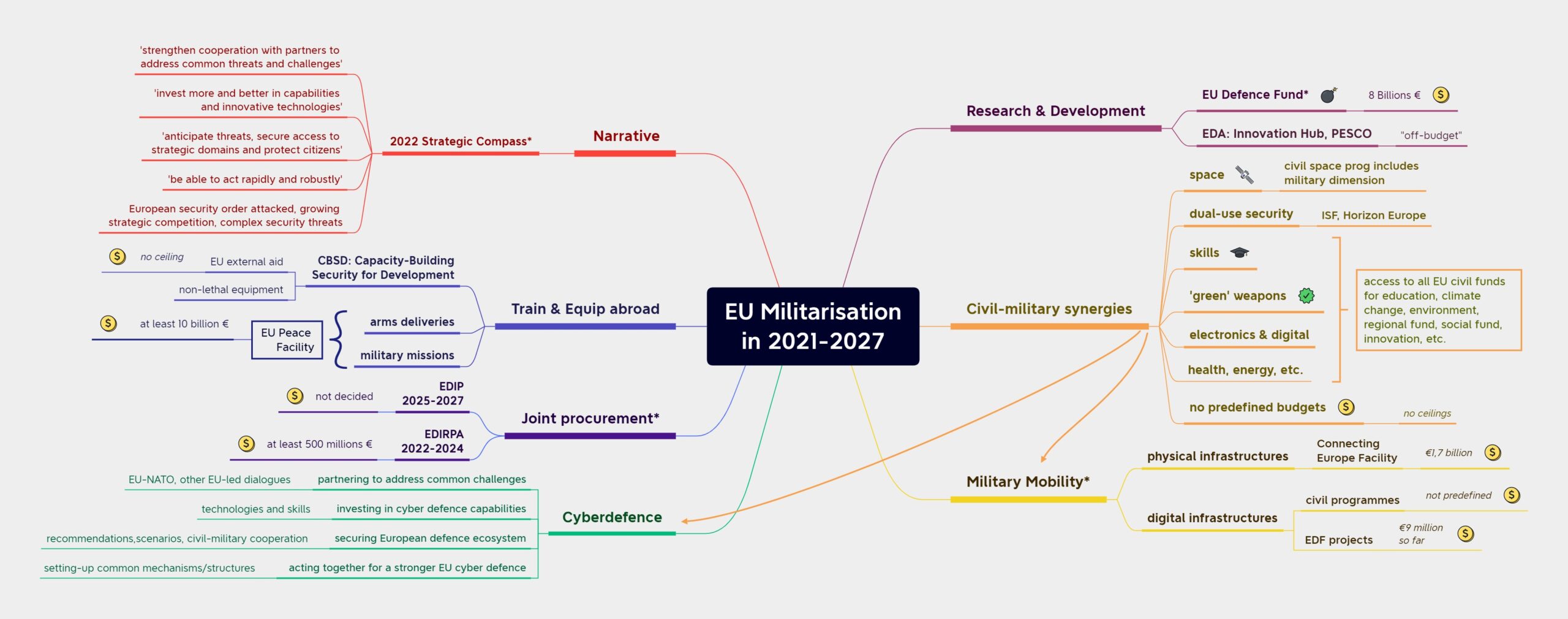
Blog article – ENAAT guest blog
“European security and defence has evolved more in the last six days than in the last two decades” claimed Ursula Von der Leyen just one week after Russian troops entered Ukraine in 2022, while Josep Borrell declared 2 days later that “with the invasion of Ukraine (…) we need to be more than a ‘soft power’ and enhance our instruments to deter reckless adversaries”.
This is a blatant case of misinformation as the militarization of the EU began long before Russia was considered a threat by the EU. The Putin-led war in Ukraine and the suffering of the Ukrainian people are being cynically instrumentalized to justify an all-out militarization that responds above all to particular industrial and geostrategic interests.
In fact the pivotal year when it comes to EU militarization is 2016, when the Commission published a Defence Action Plan paving the way to a European Defence Fund, and the EU Global Strategy putting forward a more militarised EU foreign policy. Also in 2016, the EU common budget was used for the first time to directly fund military activities, to subsidize the arms industry for the research & development (R&D) of the next generation of weaponry. EU militarisation will then greatly expand in scope and size in just a few years, as shown in this graph.
From military R&D to civil-military synergies in all possible areas, from 0 to several billion Euros
As regards scope, EU militarisation rapidly unfolded beyond military R&D with civil-military synergies in pretty much any area, in particular in military mobility to facilitate the movement of troops and military goods in and beyond Europe, for example by adapting the transport infrastructure (roads, bridges, railroads, etc.) to the movement of heavy weaponry such as tanks (see graph for more details).

It also expanded to external policies in order to “train & equip” military forces in countries facing a crisis situation. A new strategic paper for the European Union was drafted, the Strategic Compass, depicting an EU surrounded by multiple threats and prioritising the development of military capabilities over diplomacy and shared strategic visions. Although the document was formally adopted in March 2022, most of its content was drafted and agreed prior to February 2022, and was then only marginally modified to ultimately make Russia a threat.
In terms of size, the decision to exponentially increase the share of the EU budget devoted to the military was taken as early as November 2020, from half a billion in 2017-2020 to at least €10 billion for 2021-2027.
Most of it goes to the EU Defence Fund worth €8 billion, to subsidize military R&D projects by defence and security companies. But there is also a €1,5 billion military mobility programme under the EU civilian transport programme (CEF), and most civilian EU funding programs (see graph) are now accessible to the arms industry with no ceiling, making it difficult to anticipate how much money will go to military-related projects.
Lastly, a €5 billion-worth EU Peace Facility was set-up to facilitate the training and delivery of military equipment abroad, including lethal weaponry, and is now being widely used for arms deliveries to Ukraine. Although funded by Member States’ ad-hoc contributions, such “extra costs” are part of the picture when EU countries negotiate the global EU budget and its priorities.
A further acceleration is expected in 2023 and beyond
The first acceleration is about European military spending: next to skyrocketing national military expenditures, the EU budget will be revised in 2023 and there are many calls for a substantial increase of European programs subsidizing the arms industry or military projects:
– possible increase of the EU Defence Fund up to €13 billion;
– possible increase of the military mobility budget up to €6 billion;
– new funding for the joint procurement of weaponry by member states, which could amount to several billion Euros;
– The Peace Facility, recently brought to 10 billion euros, could be further increased before 2027.
This can only result in diverting resources from civilian priorities, as several countries are traditionally reluctant to increasing the global EU budget.
The second acceleration is about the EU turning into a real hard power.
On top of developing military capabilities, the EU Strategic Compass plans the creation of an EU Rapid Deployment Capacity by 2025, a modular force of up to 5’000 soldiers capable to be swiftly deployed abroad, and for which life exercises should happen in the second half of 2023.
Another planned move is to allow ‘ad-hoc’ joint military missions led by one member state to be considered as ‘EU’, meaning that costs will be shared among all EU countries. This will affect ‘neutral’ countries and engage the political responsibility of the EU as a whole, while such military operations could rather fit national geostrategic interests.
This EU hard power is also likely to be more aligned with US: the pro-NATO EU countries are currently winning the battle against the French vision of a more independent EU strategic autonomy. This is visible for example in the discussions about EU funding for joint procurements, with more and more voices calling for subsidizing with taxpayers’ money the common acquisition of non-EU military goods (mainly US weaponry). The latest EU-NATO declaration is another example, considered by many observers as “toning down strategic autonomy talk”.
A third worrisome move is the arms industry offensive for unlimited access to sustainable finance.
The arms industry claims to have great difficulty in accessing bank financing because of NGOs and ‘self-righteousness’, and the argument is being taken up by military staff, EU officials and national politicians alike.
Today, any document or declaration on military capabilities calls for facilitating, if not prioritizing, the arms industry access to all forms of EU funding, including the Recovery plan or the future EU Sovereignty Fund, but also to all forms of public and private financing, including the European Investment Bank and sustainable finance.
Behind-the-scene lobbying is already happening, and the arms industry is contesting European rules on sustainable finance like the ESG criteria, eco-labels, financial information and taxonomy that would imped their access to private finance. But what they are looking for behind this issue is even more fundamental, it is about getting a form of impunity for the armament sector:
As written in black and white in an ASD* note from October 2022, the arms industry wants to be considered as inherently compatible with sustainable finance, meaning that arms companies should be exempted from any form of assessment of the risks of corruption or bribery, or of possible negative impacts on the environment, climate or human rights. They also claim that all arms exports should be considered as legitimate as “they are approved in accordance with the export control policies of EU member States” and “satisfy rigorous criteria”.
This goes against the very concept of corporate social responsibility the EU is so keen on, and hides that current export control policies are disparate and fall short of respecting the EU Common Position and International law.
*European Aerospace, Security and Defence Industries is the main European lobby group of the arms industry
Laëtitia Sédou, 02 02 2023